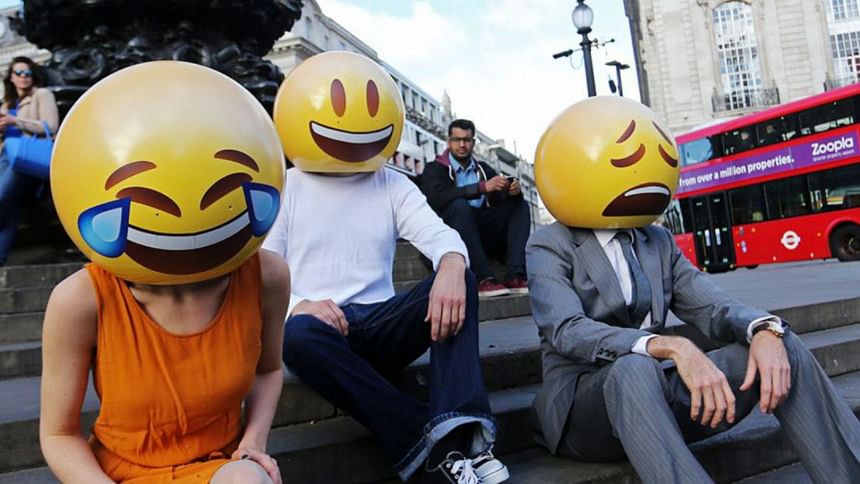It's all in a word

Last week a close friend left for an extended trip abroad. I planned to visit her the day before her departure to say good-bye, but inclement weather kept me from driving to her home. Hence, I called and left a long, emotional voice message apologising—"I'll miss you… may God be with you, etc." Her response? A text with a single emoji, that of a crying face. Frankly, I was both disappointed and puzzled at this rather callous reply to my warm message. Could she not have called back or at least sent a few words? Is it really that difficult to do?
However, I was not as upset with my friend as with emojis: They allow us to express our sentiments in an ambiguous way without actually saying anything substantive. Unfortunately, this new medium of communication is gradually becoming a substitute for articulating our feelings and opinions in words.
When I see the younger generation, particularly the Millennials, embracing the emoji culture, I don't particularly like it but I accept it. Because today's youth, mostly, dwell in the virtual world where relationships are bereft of physical contact or the sound of a warm voice. Online texts or emoticons have replaced meaningful written or verbal interactions. How this is impacting the emotional dynamics of relationships needs to be studied and analysed.
For now, I was more concerned about the emoji response from someone of my generation who grew up in an era where letter writing or conversational exchange was the common form of communication. I, too, use an emoji occasionally, but only when it complements a written message or in the course of casual interactions. I simply cannot imagine bidding farewell to a close friend with a sticker of a sobbing face. For me, these symbols are merely pictorial depictions (the term "emoji" originates from the Japanese word for picture) of a feeling or a scenery—an abridgment without specificity, devoid of the personal touch. My friend's "crying face sticker" may have been economical in terms of time and effort, but was definitely not a substitute for a warm voice, or a couple of emotive words.
I don't mean to provoke a generational debate on the appropriate use of emoji symbols. And it is highly likely that emoji enthusiasts will disagree with me, for some of them even believe that the system has literary potential: apparently the classic novel Moby Dick has been translated into emoji and sold online, for USD 200 in hardcover. Even the Library of Congress carries a copy.
While emojis have gained popularity today, the concept is not entirely new. In the past, people have toyed with the idea of creating a universal pictorial language: Francis Bacon and John Wilkins dreamed about developing a visual language that could take us back to the pre-Babel era. As a matter of fact, the earliest examples of written communication in human civilisation are the Egyptian pictographic hieroglyphs and cuneiform inscriptions from Mesopotamia about 5,000 years ago. It was only around 1,200 BC that the Phoenicians developed the first alphabets.
With time words were formed from alphabets and man learned to express the most complex emotions and feelings by using language. It opened up channels of communication between human beings who began to articulate their wants, desires, views and opinions through a common medium: language. Despite all the hype around emoji, one wonders if it can convey the subtleties that a word can. For words are not just alphabets strung together, they express deep passions, excitement, torment, ecstasy and despair in multiple forms and ways!
Perhaps the most troubling thing is that the emoji culture is having a transformational effect on not just language but also on our emotions. For it short-circuits all those emotional channels that are kindled when we search for a word to express our inner feelings. Let's also admit that there is a gulf of difference between a picture symbol and words that express our thoughts. The writings of poets, authors and historians embody the collective wisdom and emotions of a long span of human civilisation and continue to inspire and influence us in so many ways. One cannot even begin to imagine a world of communication and emotional expression without the beautiful words of Shakespeare, Tagore and Eliot.
As I looked at the emoji sticker my friend sent me, I was reminded of what Mark Twain wrote: "The difference between the almost right word and the right word is really a large matter—it's the difference between the lightning bug and the lightning." My friend's emoji message was "almost right," but it left so much unsaid. It did not, for instance, capture the trust, respect and love that we share. Instead, it seemed to say: "I didn't have time to write or call, so I sent an emoji." I wonder… was there also a message of one-upmanship: "See how cool I am, even at my age?" Cool, yes—but lacking in the warmth of soul and spirit!
Milia Ali is a renowned Rabindra Sangeet exponent and a former employee of the World Bank.





Comments